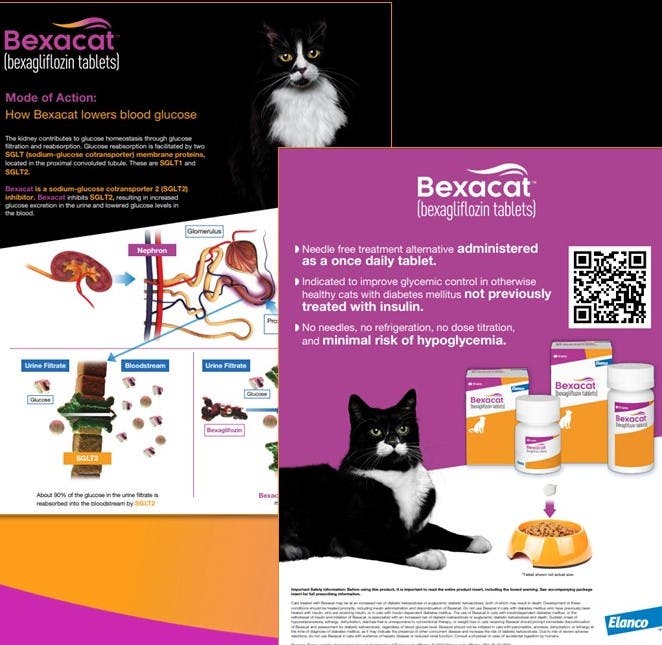Bexacat™ (bexagliflozin tablets) is the FIRST and ONLY single-dose chewable tablet for treating feline diabetes in otherwise healthy cats not previously treated with insulin.
The search for a non-insulin alternative is over.
 Provides effective glycemic control without injections and side effects of insulin
Provides effective glycemic control without injections and side effects of insulin Minimal risk of hypoglycemia and no dosage changes during treatment
Minimal risk of hypoglycemia and no dosage changes during treatment Convenient, needle-free, once-daily flavored tablet dosed independently of patient weight ensures dosing accuracy*
Convenient, needle-free, once-daily flavored tablet dosed independently of patient weight ensures dosing accuracy*
*Approved for cats weighing 6.6 lbs. (3.0 kg) or greater
How Bexacat works
Bexacat is a sodium-glucose cotransporter 2 (SGLT2) inhibitor. SGLT2 is a membrane protein found in the kidney that is responsible for reabsorption of glucose from the glomerular filtrate back into the circulation.
Bexacat Mechanism of Action
Convenient dosing
One dose given once a day ensures dosing certainty for cats weighing 6.6 lbs. (3.0 kg) or greater.
Backed by efficacy
In a series of multicenter field studies, Bexacat was proven to be effective at improving glycemic control in cats.
Target Animal Safety Study
In a well-controlled laboratory margin of safety study of healthy, non-diabetic cats, Bexacat was administered orally to 28 fasted, lean, intact adult cats at doses of at least 1X (8 cats), 3X (8 cats) and 5X (12 cats) the maximum exposure dose (5 mg/kg) once daily for 26 weeks.
- Polyuria, glucosuria (with a corresponding increase in food consumption), loose stools, diarrhea and ketonuria were reported more frequently in cats that received Bexacat than in control cats.
- There were drug-related clinically insignificant increases in calcium, magnesium and cholesterol levels, as well as decreases in creatinine and amylase levels, blood pressure and heart rate values.
- Gross necropsy demonstrated treatment-related observations of mild, diffuse zonal patterns in the liver in the 5X group.
- There were no clinically relevant, drug-related effects on hematology and coagulation parameters and organ weight values.
The potential for diabetic ketoacidosis (DKA) and euglycemic diabetic ketoacidosis (eDKA).
Cats treated with Bexacat may be at an increased risk of developing DKA or eDKA, which can be life threatening if not treated appropriately.
Due to this risk, do not use Bexacat in cats with diabetes mellitus who have previously been treated with insulin, who are receiving insulin or in cats with insulin-dependent diabetes mellitus.
Bexacat helps improve compliance by simplifying the treatment process for newly diagnosed cats:
 No dose titration needed
No dose titration needed Once-daily, chewable tablet
Once-daily, chewable tablet Can be given with food for convenient administration
Can be given with food for convenient administration No refrigeration required
No refrigeration required
Bexacat™ (bexagliflozin tablets) Resources
Stay connected with Bexacat!
Sign up to be informed about the latest news from Bexacat. You'll be the first to know about upcoming Bexacat events, courses, and other resources that will help you help your feline patients on Bexacat.

Winner of the 2023 Pet Innovation Award for Overall Cat Health Product of the Year!

Elanco is proud to be the exclusive Diabetes Category sponsor of Fear Free®.
With Fear Free® content like podcasts, blogs, and conference calls, we can help make your job easier. Interested in Fear Free® certification? We're happy to help you with savings. Learn more at fearfreepets.com.
Indication
Bexacat is indicated to improve glycemic control in otherwise healthy cats with diabetes mellitus not previously treated with insulin
Important Safety Information
Before using this product, it is important to read the entire product insert, including the boxed warning. See package insert for full prescribing information.
Cats treated with Bexacat may be at an increased risk of diabetic ketoacidosis or euglycemic diabetic ketoacidosis, both of which may result in death. Development of these conditions should be treated promptly, including insulin administration and discontinuation of Bexacat. Do not use Bexacat in cats with diabetes mellitus who have previously been treated with insulin, who are receiving insulin, or in cats with insulin-dependent diabetes mellitus. The use of Bexacat in cats with insulin-dependent diabetes mellitus, or the withdrawal of insulin and initiation of Bexacat, is associated with an increased risk of diabetic ketoacidosis or euglycemic diabetic ketoacidosis and death. Sudden onset of hyporexia/anorexia, lethargy, dehydration, diarrhea that is unresponsive to conventional therapy, or weight loss in cats receiving Bexacat should prompt immediate discontinuation of Bexacat and assessment for diabetic ketoacidosis, regardless of blood glucose level. Bexacat should not be initiated in cats with pancreatitis, anorexia, dehydration, or lethargy at the time of diagnosis of diabetes mellitus, as it may indicate the presence of other concurrent disease and increase the risk of diabetic ketoacidosis. Due to risk of severe adverse reactions, do not use Bexacat in cats with evidence of hepatic disease or reduced renal function. Consult a physician in case of accidental ingestion by humans.














